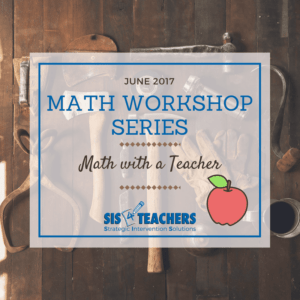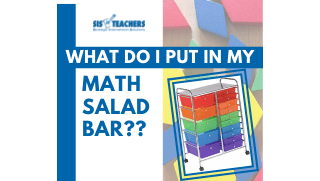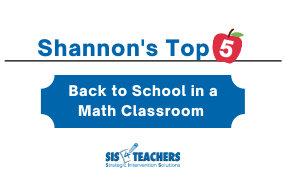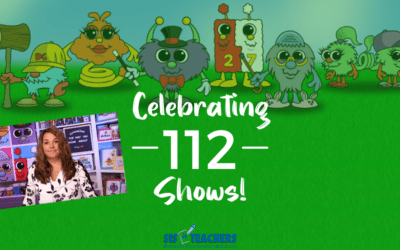Our first stop in the Math Workshop rotation is Math with a Teacher!
Math with a Teacher is a time for guided instruction in a small group. Just like during guided reading, we want to be aware of the skill sets of the students in our groups. You will probably have three or four groups, depending on the number of students in your class. (See our first post in the series for how we organize the groups in rotation.) I recommend grouping by ability, using math assessment or numeracy screener results. You will probably have one group of at-risk students, two of mid-/grade-level students, and one group of advanced or gifted students. We want to make sure we tailor our instruction during this time to the needs of the students in each group, and avoid simply repeating the whole class lesson four times in each small group.
Mini-Lesson and Planning for Guided Math
Before you can start a guided math group, however, you have to decide what you want to address in your mini-lesson. (Be sure to download our Math with a Teacher planning documents to help keep you organized!) A mini-lesson is a short whole-class instruction time on a concept linked to what you’re going to be doing in Math with a Teacher. No matter what textbook or curriculum you use (Everyday Math, Go Math, Eureka Math), make sure to address the main objective. When we start with this, we can use backwards design to get to the meat of what kids need help with in the lesson.
For example, let’s say the objective is that the student will be able to read an addition statement and decide if it is true or false, determining if it’s equal to, greater than or less than. In the mini-lesson, you want to whet the students’ appetites and get them interested. You might start with a pretense of a balance scale. One one side, you have 5 blue unifix cubes and 2 red ones, and on the other side, next to the scale, you have 4 green cutes and 3 yellow ones. Tell your students, “I think these are equal. How could we find out?” By doing this, you are giving the students the idea of what you’re going to be teaching. You aren’t looking for mastery during this time, but just getting their feet wet for what you’re going to be covering during the guided lesson.
Then, you have to assess each group’s understanding of the greater than/less than idea so you can prepare their guided lesson. Do they understand quantities? Do they understand number sentences? As you evaluate where they are with a skill, you can determine what supplies they might need. Do some kids need base ten blocks? Do they need abacus? Should we get a balance out? You won’t alter the objective, but you do need to think through how you will differentiate the concept in each grouping. Think through CPA. Which group of students needs their instruction to be concrete? Which group needs to visualize pictorial instruction – dry erase boards. Which group needs it in the abstract but needs higher level application?Give yourself some time to plan.
 During your Math with a Teacher time, you will want to have a mini Math Salad Bar with you. Grab a dishtub from the dollar store and, for the lower grades, throw in some Counting Buddies, a rekenrek, a double ten frame. For upper grades, you might include place value strips and discs so you can show your students whole numbers and decimals. Remember, the manipulatives are for the students – even in a guided math group! The mini Salad Bar allows you to pull out the things the students need quickly, without wasting time retrieving the tools from across the room between each group. The students are the ones building and interacting with the tools at your direction.
During your Math with a Teacher time, you will want to have a mini Math Salad Bar with you. Grab a dishtub from the dollar store and, for the lower grades, throw in some Counting Buddies, a rekenrek, a double ten frame. For upper grades, you might include place value strips and discs so you can show your students whole numbers and decimals. Remember, the manipulatives are for the students – even in a guided math group! The mini Salad Bar allows you to pull out the things the students need quickly, without wasting time retrieving the tools from across the room between each group. The students are the ones building and interacting with the tools at your direction.
Logistics of Math with a Teacher
Part of building responsibility within the Math Workshop is having students come to their guided math group prepared. They need a clear understanding of what supplies they are expected to have: maybe a pencil, math journal and the independent practice sheet from their math workbook, a dry erase board and marker. Whether you decide to use our i-chart of expectations or develop your own, establish those expectations clearly so the students are not wasting time because “they don’t have a pencil.”
Some teachers will want to get the other groups settled, so they’ll have something immediate for the group to do when they arrive with at the Math with a Teacher station. As I’m checking in around the room, my guided math group already has their supplies and a problem to work on based on what I talked about in the mini-lesson.
I always like to take my most at-risk students into Math with a Teacher because they need more time to get the idea. The more advanced students could be put into Math by Myself to start because, by the time they get to Math with a Teacher, I can check the problems they’ve completed, review the objective, and go deeper with the concepts. You don’t want each guided math group to look the same.
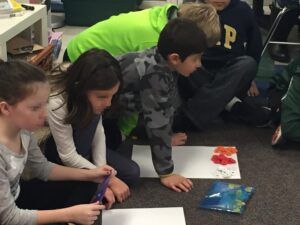 A guided math group does NOT have to be the picture of small group perfection with exactly five students seated politely at a kidney-shaped table engaging with their work. Math with a Teacher time could be on the floor in front of the smartboard with ten kids in front of you in a rainbow or U-shape. In this picture, all the students can see you, you can have students interact with the board, and you have the ability to see and guide each student in the group. Don’t wait for it to be perfect, just jump in!
A guided math group does NOT have to be the picture of small group perfection with exactly five students seated politely at a kidney-shaped table engaging with their work. Math with a Teacher time could be on the floor in front of the smartboard with ten kids in front of you in a rainbow or U-shape. In this picture, all the students can see you, you can have students interact with the board, and you have the ability to see and guide each student in the group. Don’t wait for it to be perfect, just jump in!
A common complaint when implementing Math Workshop rotations is that teachers feel like they can’t get to all their groups in one day. If this is the case, you might try having fewer groups (maybe 3) with more students in each (10 or so). With fewer groups, you can ensure you get to all of them during the rotation times. This approach is better than “one size fits all” instruction, because when we do a whole class lesson, we actually end up reaching fewer students. In the whole class setting, the same students that always have their hands up still be giving the answers, and the students who don’t tend to engage still won’t be getting the instruction that they need. So, in a smaller group, even a larger small group, students will still be able to receive more targeted instruction than they would in a whole class lesson.
Typically, students leave Math with a Teacher and go right into Math by Myself. They’ve just had the lesson with you, now it’s time to see if they can actually apply it. Before you release the students, however, select “must do” and “could do” problems for them. Having students complete all thirty problems on a worksheet is a thing of the past and doesn’t represent quality instruction. It’s better for students to focus on appropriately and successfully applying their strategies with two problems, than rush through thirty.
I like to get my guided math group started in their Math by Myself work before I release them, especially with my at-risk group. We might work through the first problem together at the end of our group, then it’s time to rotate. I’ll ask the students to complete whichever other problems I’ve identified for them in their Math by Myself time.
Resources:
Guided Math Workshop – Rotation Expectations

